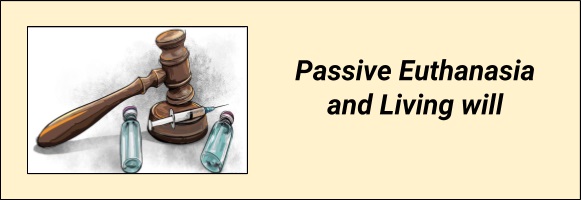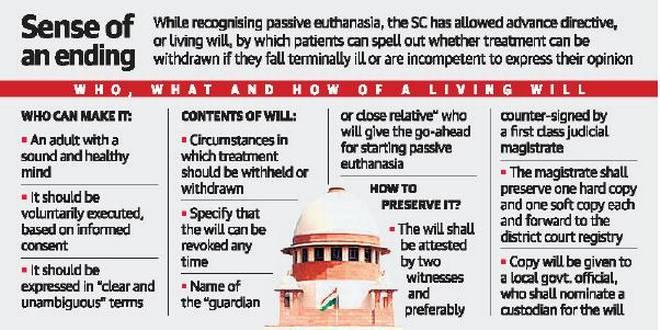(HOT) UPSC Current Affairs 2025 PDF
NEW! The Gist (NOV-2025) | E-BOOKS
Passive Euthanasia and Living will : Important Topics for UPSC Exams

Passive Euthanasia and Living will : Important Topics for UPSC Exams
News:
Upholding the right to die with dignity, the Supreme Court on Friday gave legal sanction to passive euthanasia and execution of a living will of persons suffering from chronic terminal diseases and likely to go into a permanent vegetative state.
Terms:
-
Euthanasia: Euthanasia is the practice of intentionally ending a life to relieve pain and suffering. Euthanasia is categorized in different ways, which include voluntary, non-voluntary, or involuntary.
Non-voluntary euthanasia (patient's consent unavailable), Involuntary euthanasia (without asking consent or against the patient's will),voluntary is by the consent
-
Passive and Active Euthanasia: Passive euthanasia entails the withholding treatment necessary for the continuance of life. It is legal in US.
Active euthanasia entails the use of lethal substances or forces (such as administering a lethal injection). Active voluntary euthanasia is legal in Belgium, Luxembourg and the Netherlands.
-
Persistent vegetative state: A persistent vegetative state (PVS) is a disorder of consciousness in which patients with severe brain damage are in a state of partial arousal rather than true awareness.
-
living will : is a written document that allows a person to give explicit instructions in advance about the medical treatment to be administered when he or she is terminally ill or no longer able to express informed consent.
Buy Printed Complete Study Materials for UPSC IAS PRELIMS Exam
Online Crash Course for UPSC PRE Exam
Background:
Aruna Shanbaug Case : Aruna Shanbaug was a nurse working at the King Edward Memorial Hospital. After being sodomized, she was left in a vegetative state. The Supreme Court made its on the issue in 2011, The court rejected the plea to discontinue Aruna's life support but issued a set of broad guidelines legalising passive euthanasia in India.
The following guidelines were laid down:
-
A decision has to be taken to discontinue life support either by the parents or the spouse or other close relatives, or in the absence of any of them, such a decision can be taken even by a person or a body of persons acting as a next friend. It can also be taken by the doctors attending the patient. However, the decision should be taken bona fide in the best interest of the patient.
-
Even if a decision is taken by the near relatives or doctors or next friend to withdraw life support, such a decision requires approval from the High Court concerned.
-
When such an application is filled the Chief Justice of the High Court should forthwith constitute a Bench of at least two Judges who should decide to grant approval or not.
Recent decision :
-
Supreme court recognised a person's right to die with dignity while giving sanction to passive euthanasia and living will.
-
The Supreme Court said that it has laid down guidelines on who would execute the will and how a nod for passive euthanasia would be granted by the medical board.
-
In the event of the executor becoming terminally ill with no hope of recovery, the physician treating the patient after informing the executor/his guardian about the nature of illness and consequences of alternative forms of treatment will set up a hospital medical board.
-
Guidelines and directives shall remain in force till a legislation is brought to deal with the issue.

Arguments in favour of the judgment ( Living will and passive euthanasia):
-
Right to Die : Right to die peacefully is part of Fundamental Right to Life guaranteed under Article 21 of the Constitution. Article 21 provides that "no person shall be deprived of his life or personal liberty except according to procedure established by law".
-
A person cannot be forced to live on support of ventilator. Keeping a patient alive by artificial means against his/her wishes is an assault on his/her body.
-
The government in the recently passed mental healthcare bill had liberalized the stance on suicide in which it referred to an attempt to suicide as an indicator of mental illness, In this case it is a matter of urgency and right to die with dignity.
-
Pallative care in some cases is in itself is form of assisted suicide.
Arguments against the decision:
-
In 1998, Gian Kaur case where a constitutional bench had held that the right to life did not include the right to die.
-
The centre had opposed the concept of living will on grounds that consent for removal of artificial support may not be an informed one and could be misused in cases of the elderly.
-
Various countries across the world disallow creation of living will by the patients.
-
It is also a case of judicial activism where the decision is being taken by the court instead of centre framing a law in this regard.
Way Forward
-
The decision of supreme court to allow passive euthanasia and Living will is a landmark judgment and upholds the fundamental right of life which includes the tight to die with dignity.
-
The 241st report of the Law Commission states that passive euthanasia should be allowed with certain safeguards and there is a proposed law—Medical Treatment of Terminally Ill Patient (Protection of Patients and Medical Practitioners) Bill, 2006 in this regard.
-
The centre must frame a suitable legislation and get it passed to clear any confusions that may arise from the order.
MODEL QUESTIONS
Mains Questions

